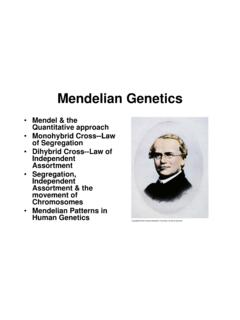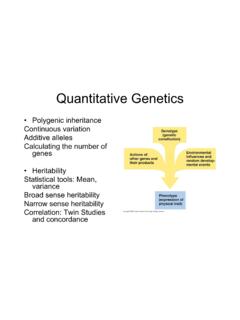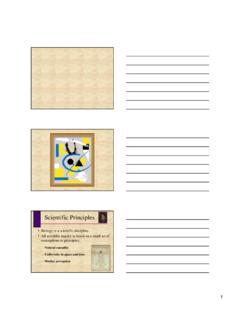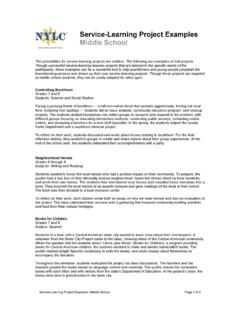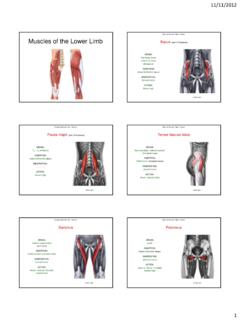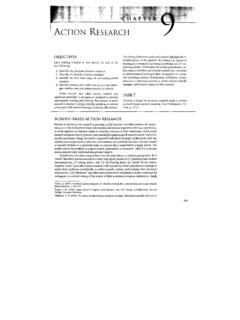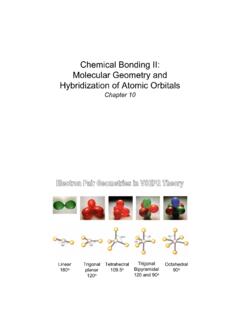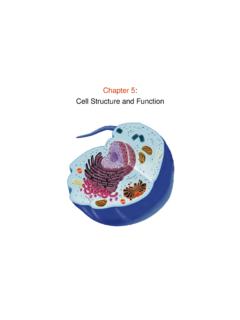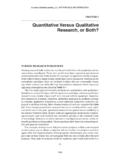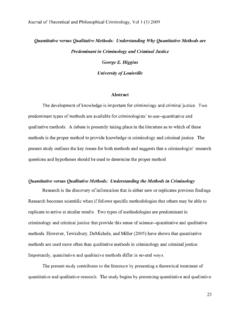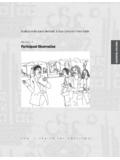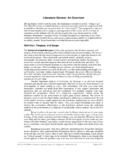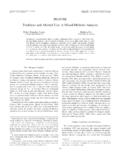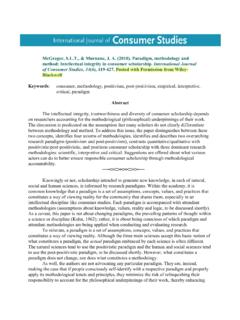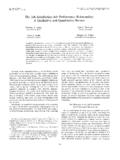Transcription of Focus on Research Methods - Western Oregon …
1 Research in Nursing & Health, 2000, 23, 334 340 Focus on Research MethodsWhatever Happened toQualitative Description?Margarete Sandelowski*University of North Carolina at Chapel Hill, #7640, Carrington Hall, School of Nursing,Chapel Hill, NC 27599 Received 10 September 1999; accepted 14 January 2000 Abstract:The general view of descriptive Research as a lower level form ofinquiry has in uenced some researchers conducting qualitative Research toclaim Methods they are really not using and not to claim the method they areusing: namely, qualitative description. qualitative descriptive studies haveas their goal a comprehensive summary of events in the everyday terms ofthose events. Researchers conducting qualitative descriptive studies stayclose to their data and to the surface of words and events. Qualitativedescriptive designs typically are an eclectic but reasonable combination ofsampling, and data collection, analysis, and re-presentation descriptive study is the method of choice when straight descrip-tions of phenomena are John Wiley & Sons, Inc.
2 Res Nurs Health23:334 340, 2000 Keywords: qualitative description; qualitative Research Methods ; qualitative content analysis; description and interpretationQualitative researchers now have the option tochoose from an increasing array of theoreticallyand technically sophisticated Methods . Accord-ingly, it may seem strange to resurrect a plainerand considerably ``less sexy''1method: namely, qualitative description. Yet it is precisely theincreasing complexity of qualitative Methods andthe tyranny of method in nursing Research thatmakes the rediscovery of qualitative Research is typically depicted inresearch texts as being on the lowest rung of thequantitative Research design hierarchy. In thishierarchy, ``true'' experiments aimed at predic-tion and control are the gold standard and anyother design isnon-experimental and weak ( ,Talbot, 1995). The view of description in quan-titative Research as the ``crudest form of inquiry''(Thorne, Kirkham, & MacDonald-Emes, 1997,p.)
3 170) likely has negatively in uenced Research -ers engaging in qualitative Research , many ofwhom have felt obliged to defend their efforts assomething more than mere description. That is,they have sought ``epistemological credibility''(p. 170) by designating their work as phenomen-ology, grounded theory, ethnography, or narrativestudy. In too many cases, however, this effort hasresulted in ``posturing'' (Wolcott, 1992) aboutphenomenology, grounded theory, ethnography,or narrative study rather than in phenomenolo-gies, theories, ethnographies, or narrative inter-pretations. A confusing state of affairs existswhereby studies are called narrative, even thoughthey may include nothing more than minimallystructured, open-ended interviews; phenomeno-logic, even though they may include nothing morethan reports of the ``subjective'' experiences ofparticipants; or, ethnographic, even though they* am indebted to Joan Lynaugh for the phrase ``lesssexy,'' which she used to refer to things that areimportant but nevertheless fail to get the attentionthey John Wiley & Sons, include nothing more than participants indifferent ethnic groups.
4 Indeed, although they mayundeniably be worthwhile studies that yield valu-able information for practice, these so-called nar-rative, phenomenologic, and ethnographic studiesare often better described as qualitative descriptivestudies, albeit with narrative, phenomenologic, andethnographic overtones. I will return to the subjectof overtones in qualitative Research the now vast qualitative Methods literature,there is no comprehensive description of qualita-tive description as a distinctive method of equalstanding with other qualitative Methods , althoughit is one of the most frequently employedmethodologic approaches in the practice disci-plines. Accordingly, in this paper, I describequalitative description as a method that Research -ers can claim unashamedly without resorting tomethodological acrobatics. My presentation ofqualitative description was inspired, in part,by Thorne, Kirkham, and MacDonald-Emes'insightful discussion of ``interpretive descrip-tion'' (1997), but departs from that discussion andfrom Thorne's (1991) earlier related discussion of``methodological orthodoxy'' in three ways.
5 First,I see qualitative description as a categorical, asopposed to ``noncategorical alternative'' forinquiry; that is, the method already exists but isrelatively unacknowleged, as opposed to being anew, distinctively nursing adaptation of groundedtheory, phenomenology, and ethnography. Sec-ond, I see qualitative descriptive studies as lessinterpretive than ``interpretive description'' inthat they do not require researchers to move as farfrom or into their data. Third, they do not requirea conceptual or otherwise highly abstract render-ing of data. My depiction of qualitative descrip-tion departs from Artinian's useful discussion ofthe ``descriptive mode'' of qualitative inquiry(1988) in that I view it as producing a completeand valued end-product in itself, rather than asan ``entry point'' (p. 139) into other qualitativestudies: as she presented it, as a necessary preludeto grounded theory refer to the method I present here asbasicorfundamentalqualitative description to differenti-ate it from other kinds of qualitative description,such as phenomenology, grounded theory, andethnography.
6 Phenomenologic, grounded theory,and ethnographic studies are not exclusively inthe descriptive domain, though, as they may alsobe used to explain phenomena. Unfortunately, thewordsbasic,fundamental, andsurface(a wordI use later in this article) connote somethingelementary, super cial, simple, or merely preli-minary. In no way do I wish to reinforce, by usingthese words, those invidious hierarchies thatpresent one method as easier, less valuable, lessdesirable, or less scienti c than another. Nomethod is absolutely weak nor strong, but rathermore or less useful or appropriate in relation tocertain purposes. Accordingly, I present qualit-ative description here as a valuable method byitself. Comparisons to other Methods are for thepurposes of illumination, not ranking or DESCRIPTIONVERSUS QUANTITATIVEDESCRIPTION AND OTHERQUALITATIVE METHODSAll inquiry entails description, and all descriptionentails interpretation.
7 Knowing any phenomenon(or event or experience) requires, at the very least,knowing the ``facts'' about that phenomenon. Yetthere are no ``facts'' outside the particular contextthat gives those facts meaning. Descriptionsalways depend on the perceptions, inclinations,sensitivities, and sensibilities of the describer( , Emerson, Fretz, & Shaw, 1995; Giorgi,1992; Wolcott, 1994). ``There is no pure lookingwith a naked, innocent eye'' (Pearce, 1971, p. 4),and there is no ```immaculate perception''' (Beercited in Wolcott, 1994, p. 13). Researchers seek-ing to describe an experience or event select whatthey will describe and, in the process of featuringcertain aspects of it, begin to transform thatexperience or no description is free of interpretation,basic or fundamental qualitative description, asopposed to, for example, phenomenological orgrounded theory description, entails a kind ofinterpretation that is low-inference, or likely toresult in easier consensus among researchers.
8 Eventhough one researcher may feature the feelings anda second researcher the events a woman reported inan interview, both researchers will likely agreethat, for example, the woman stated several timesthat she was angry and that she stated that hermother died one day after she herself learned shehad breast cancer. In the case of two researchersdescribing ostensibly the same scene, oneresearcher might feature the spatial arrangementin a room, while the second researcher will featurethe social interactions. But both researchers oughtto agree with each other's descriptions as accuraterenderings of the scene. That is, with low-inferencedescriptions, researchers will agree more readilyon the ``facts'' of the case, even if they may notfeature the same facts in their whether in the form of descriptiveQUALITATIVE DESCRIPTION / SANDELOWSKI335summaries of interview or observation data entail researchers' choices about what to these descriptions must always accuratelyconvey events in their proper sequence, or havedescriptive validity, and the meanings participantsattributed to those events, or have interpretivevalidity (Maxwell, 1992).
9 Although human beingscan never, and will likely never want to, describeeverything that is ``there,'' what they choose todescribe will be something that most observerswould agree is in fact ``there.''Accordingly, although unavoidably interpre-tive, in that it is `` ltered through (human)perceptions'' (Wolcott, 1994, p. 13), basic quali-tative description is not highly interpretive in thesense that a researcher deliberately chooses todescribe an eventin terms ofa conceptual,philosophical, or other highly abstract frameworkor system. The description in qualitative descrip-tive studies entails the presentation of the facts ofthe case in everyday language. In contrast,phenomenological, theoretical, ethnographic, ornarrative descriptions re-present events in otherterms. Researchers are obliged to put much moreof their own interpretive spin on what they seeand hear.
10 This spin derives, in part, from thesemethodologies themselves. Grounded theorystudy inclines the researcher to look for, andinterpret data as, elements in a ``conditional/consequential matrix'' (Strauss & Corbin, 1998,p. 181). Certain types of phenomenologic studiesincline the researcher to look for, and interpretdata in terms of, ``lifeworld existentials,'' such ascorporeality and temporality (Van Manen, 1990,p. 101). Such descriptions require researchers tomove farther into or beyond their data as theydemand not just reading words and scenes, butrather reading into, between, and over them ( ,McMahon, 1996; Poirier & Ayres, 1997). Wertz'(1983) analysis of the ``moments'' of a phenom-enological study is an excellent demonstration ofthe successive transformations from a partici-pant's description of an event to a researcher'sphenomenological description of that less interpretive than phenomenolo-gical or grounded theory description, fundamen-tal qualitative description is more interpretivethan quantitative description, which typicallyentails surveys or other pre-structured means toobtain a common dataset on pre-selected vari-ables, and descriptive statistics to summarizethem.
